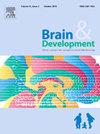识别需要干预的共济失调:儿科急诊科患者预后不良因素的回顾性队列研究
IF 1.3
4区 医学
Q4 CLINICAL NEUROLOGY
引用次数: 0
摘要
目的探讨急性发作性共济失调患儿预后不良的潜在影响因素,为早期干预提供指导。方法2014年1月至2024年5月在国家儿童健康与发展中心进行单中心回顾性队列研究。0-18岁的儿童患者在症状出现后7天内出现急性发作性共济失调,不包括那些预先诊断为共济失调原因的患者。根据最终诊断和预后将患者分为两组:低危患者为良性急性小脑性共济失调(ACA)组,高危患者为临床紧急神经病理学(CUNP)组。统计分析,包括卡方检验和多元逻辑回归,以确定预后因素。结果共纳入59例患儿:良性ACA组34例,CUNP组25例。单因素分析显示,两组患者在头痛、呕吐、震颤或认知障碍、年龄≥5岁、症状持续时间超过3天等方面存在显著差异。多因素分析显示,年龄≥5岁(比值比[OR] 22.2, 95%可信区间[CI] 1.8-640.2)和症状持续时间超过3天(比值比[OR] 8.1, 95%可信区间[CI] 1.5-68.6)与预后较差显著相关。结论年龄≥5岁且症状持续3天以上的儿童患者更容易需要治疗或出现后遗症。在这种情况下,早期诊断评估是重要的,以避免延迟干预。本文章由计算机程序翻译,如有差异,请以英文原文为准。
Recognizing ataxia requiring intervention: a retrospective cohort study of poor prognostic factors in pediatric emergency department patients
Purpose
We aimed to explore the potential prognostic factors associated with poorer outcomes in pediatric patients presenting with acute-onset ataxia to guide early intervention.
Methods
This single-center retrospective cohort study was conducted at the National Center for Child Health and Development between January 2014 and May 2024. Pediatric patients aged 0–18 years who presented with acute-onset ataxia within 7 days of symptom onset were included, excluding those with pre-diagnosed causes of ataxia. Patients were divided into two groups based on their final diagnosis and prognosis: the benign acute cerebellar ataxia (ACA) group for low-risk patients and the clinically urgent neurological pathology (CUNP) group for high-risk patients. Statistical analyses, including chi-square tests and multivariate logistic regression, were performed to identify prognostic factors.
Results
In total, 59 children were included: 34 in the benign ACA group and 25 in the CUNP group. Univariate analysis showed significant differences in headache, vomiting, tremors or dysmetria, age ≥ 5 years, and symptom persistence beyond 3 days between the two groups. Multivariate analysis indicated that age ≥ 5 years (odds ratio [OR] 22.2, 95 % confidence interval [CI] 1.8–640.2) and symptom persistence over 3 days (OR 8.1, 95 % CI 1.5–68.6) were significantly associated with poorer outcomes.
Conclusion
Pediatric patients aged ≥5 years with symptoms persisting for more than 3 days are more likely to require treatment or develop sequelae. Early diagnostic evaluation is important in such cases to avoid delayed intervention.
求助全文
通过发布文献求助,成功后即可免费获取论文全文。
去求助
来源期刊

Brain & Development
医学-临床神经学
CiteScore
3.60
自引率
0.00%
发文量
153
审稿时长
50 days
期刊介绍:
Brain and Development (ISSN 0387-7604) is the Official Journal of the Japanese Society of Child Neurology, and is aimed to promote clinical child neurology and developmental neuroscience.
The journal is devoted to publishing Review Articles, Full Length Original Papers, Case Reports and Letters to the Editor in the field of Child Neurology and related sciences. Proceedings of meetings, and professional announcements will be published at the Editor''s discretion. Letters concerning articles published in Brain and Development and other relevant issues are also welcome.
 求助内容:
求助内容: 应助结果提醒方式:
应助结果提醒方式:


